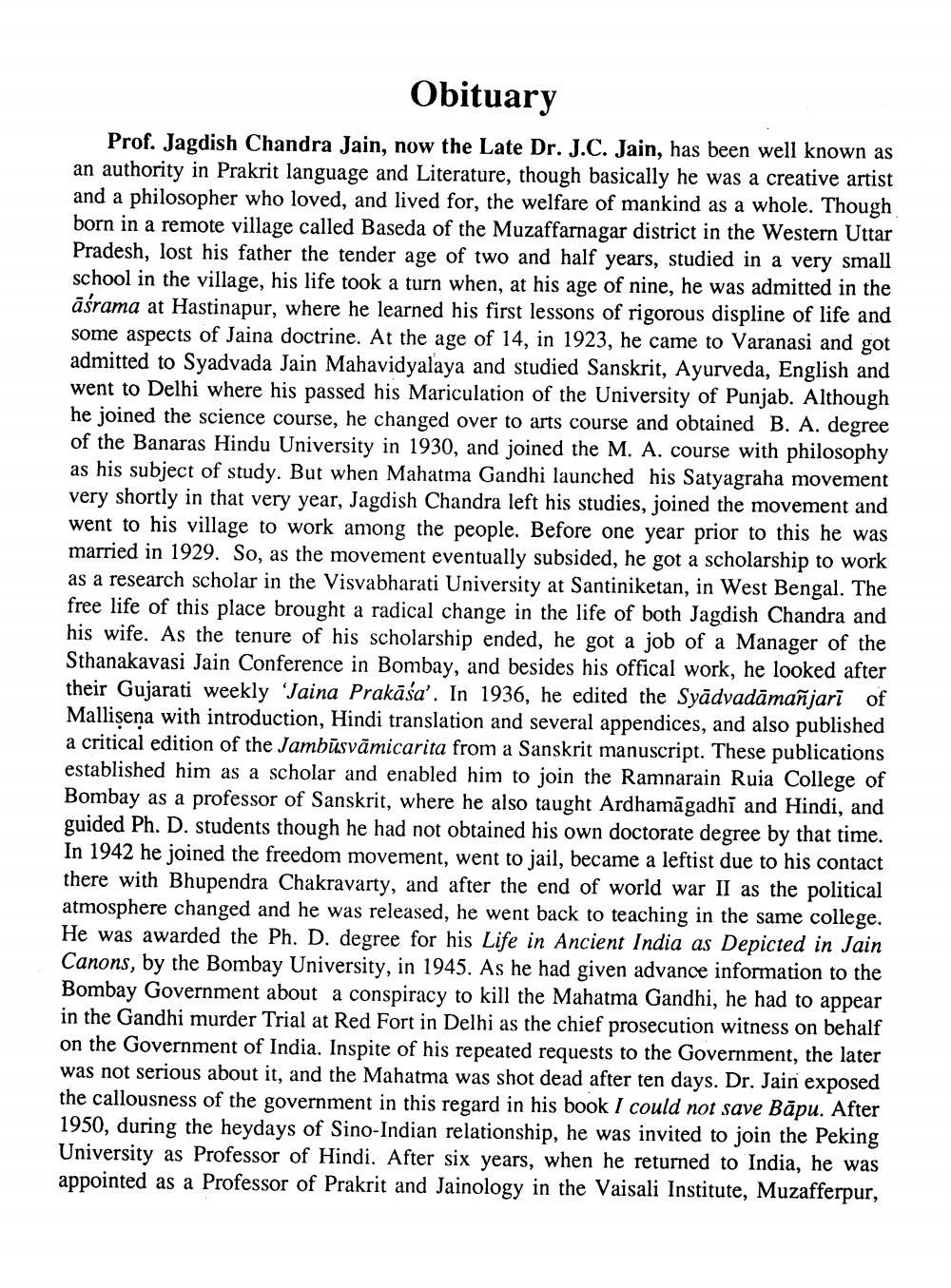________________
Obituary
Prof. Jagdish Chandra Jain, now the Late Dr. J.C. Jain, has been well known as an authority in Prakrit language and Literature, though basically he was a creative artist and a philosopher who loved, and lived for, the welfare of mankind as a whole. Though born in a remote village called Baseda of the Muzaffarnagar district in the Western Uttar Pradesh, lost his father the tender age of two and half years, studied in a very small school in the village, his life took a turn when, at his age of nine, he was admitted in the āśrama at Hastinapur, where he learned his first lessons of rigorous displine of life and some aspects of Jaina doctrine. At the age of 14, in 1923, he came to Varanasi and got admitted to Syadvada Jain Mahavidyalaya and studied Sanskrit, Ayurveda, English and went to Delhi where his passed his Mariculation of the University of Punjab. Although he joined the science course, he changed over to arts course and obtained B. A. degree of the Banaras Hindu University in 1930, and joined the M. A. course with philosophy as his subject of study. But when Mahatma Gandhi launched his Satyagraha movement very shortly in that very year, Jagdish Chandra left his studies, joined the movement and went to his village to work among the people. Before one year prior to this he was married in 1929. So, as the movement eventually subsided, he got a scholarship to work as a research scholar in the Visvabharati University at Santiniketan, in West Bengal. The free life of this place brought a radical change in the life of both Jagdish Chandra and his wife. As the tenure of his scholarship ended, he got a job of a Manager of the Sthanakavasi Jain Conference in Bombay, and besides his offical work, he looked after their Gujarati weekly Taina Prakāśa'. In 1936, he edited the Syādvadāmañjarī of Mallisena with introduction, Hindi translation and several appendices, and also published a critical edition of the Jambūsvāmicarita from a Sanskrit manuscript. These publications established him as a scholar and enabled him to join the Ramnarain Ruia College of Bombay as a professor of Sanskrit, where he also taught Ardhamāgadhi and Hindi, and guided Ph. D. students though he had not obtained his own doctorate degree by that time. In 1942 he joined the freedom movement, went to jail, became a leftist due to his contact there with Bhupendra Chakravarty, and after the end of world war II as the political atmosphere changed and he was released, he went back to teaching in the same college. He was awarded the Ph. D. degree for his Life in Ancient India as Depicted in Jain Canons, by the Bombay University, in 1945. As he had given advance information to the Bombay Government about a conspiracy to kill the Mahatma Gandhi, he had to appear in the Gandhi murder Trial at Red Fort in Delhi as the chief prosecution witness on behalf on the Government of India. Inspite of his repeated requests to the Government, the later was not serious about it, and the Mahatma was shot dead after ten days. Dr. Jain exposed the callousness of the government in this regard in his book I could not save Bāpu. After 1950, during the heydays of Sino-Indian relationship, he was invited to join the Peking University as Professor of Hindi. After six years, when he returned to India, he was appointed as a Professor of Prakrit and Jainology in the Vaisali Institute, Muzafferpur,




